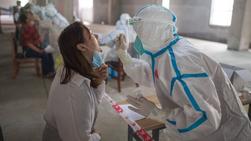 Residents take nucleic acid tests at a testing site in Wuhan, Central China's Hubei province, May 15, 2020. (PHOTO / XINHUA)
Residents take nucleic acid tests at a testing site in Wuhan, Central China's Hubei province, May 15, 2020. (PHOTO / XINHUA)
The 300 asymptomatic COVID-19 cases identified in Wuhan, Hubei province, during a recent mass testing effort are carrying a low amount of the virus and are not infectious, the city's health commission said.
Samples collected from the throats of carriers, including their sputum, were sent to the Wuhan Institute of Virology for virus nurturing, and no live virus was nurtured in any of the samples, the commission said in a statement on Monday.
This either indicates an extremely low amount of novel coronavirus in these samples, or shows no active virus that can cause disease exists in the samples, the commission said.
ALSO READ: Vaccine candidate shows promise
The biggest probability is that the samples contained no live virus that can cause infection but just fragments of nucleic acid of the virus
Jin Qi, Director, the Chinese Academy of Medical Sciences' Institute of Pathogen Biology
Personal items used by the asymptomatic cases, including toothbrushes, cups, masks and towels, also tested negative for the virus.
In addition, all 1,174 close contacts of the 300 cases tested negative for the virus, which proves these asymptomatic cases are not infectious.
The 300 cases were identified during a mass test in Wuhan between May 14 and June 1, which covered nearly 10 million residents. Several days before the test, Wuhan had reported six new confirmed cases in two days after more than a month of no newly reported confirmed cases.
Jin Qi, director of the Chinese Academy of Medical Sciences' Institute of Pathogen Biology, said there has been no determination made yet on the infectiousness of asymptomatic COVID-19 cases, who test positive for the nucleic acid of the coronavirus but do not show symptoms.
There may be different causes for the fact that no live virus was nurtured from the samples of the asymptomatic cases in Wuhan, including that the samples contained very little live virus for them to reproduce during nurturing, he said.
"The biggest probability is that the samples contained no live virus that can cause infection but just fragments of nucleic acid of the virus," Jin said. "Testing positive for nucleic acid of the virus does not necessarily mean the person can discharge active virus that can cause infection."
The presence of asymptomatic cases has caused an additional challenge for the control and prevention of COVID-19, with some experts believing such cases could also be infectious. Wu Zunyou, chief epidemiologist at the Chinese Center for Disease Control and Prevention, said patients with the novel coronavirus could be infectious one or two days before they show symptoms.
READ MORE: China shows best practices in virus battle, experts say
As the possibility that the infectiousness of asymptomatic COVID-19 cases cannot be ruled out, they also need to be put under isolation to minimize risks, Jin said.
All asymptomatic cases identified in China are subject to a 14-day isolation period for medical observation and can only be released after they test negative for the nucleic acid of the virus twice consecutively.
The Chinese mainland reported 21 asymptomatic COVID-19 cases on Monday, in addition to three confirmed cases, according to the National Health Commission.


